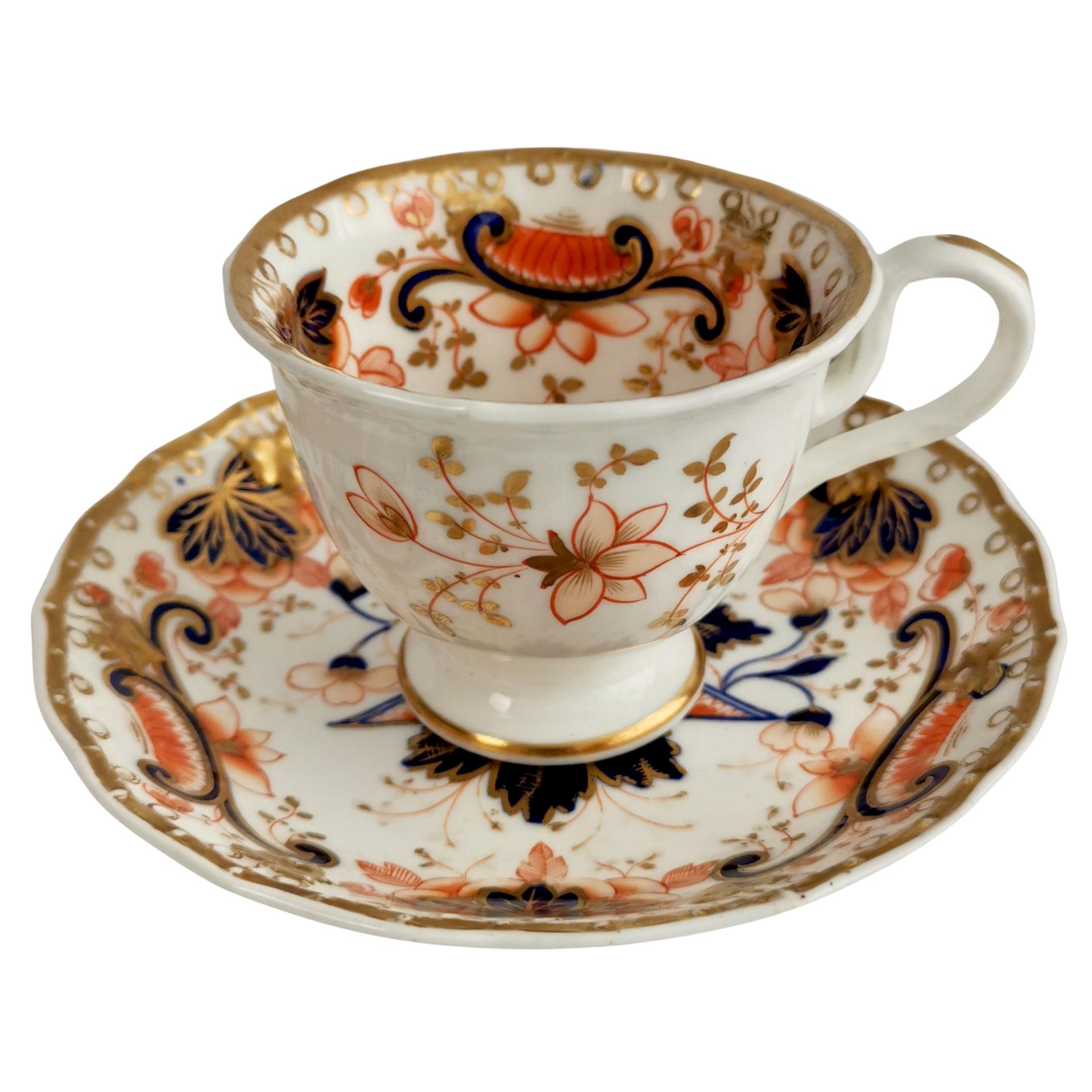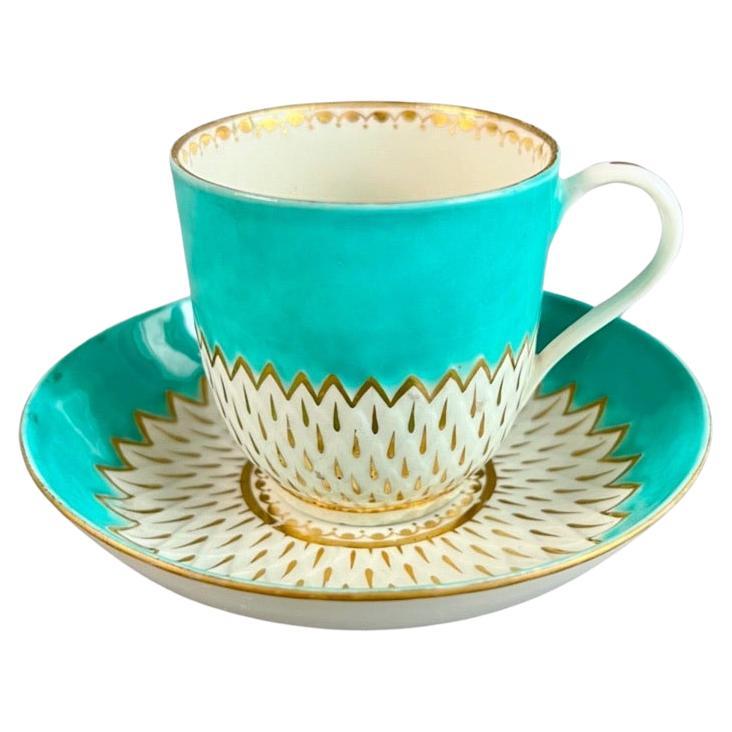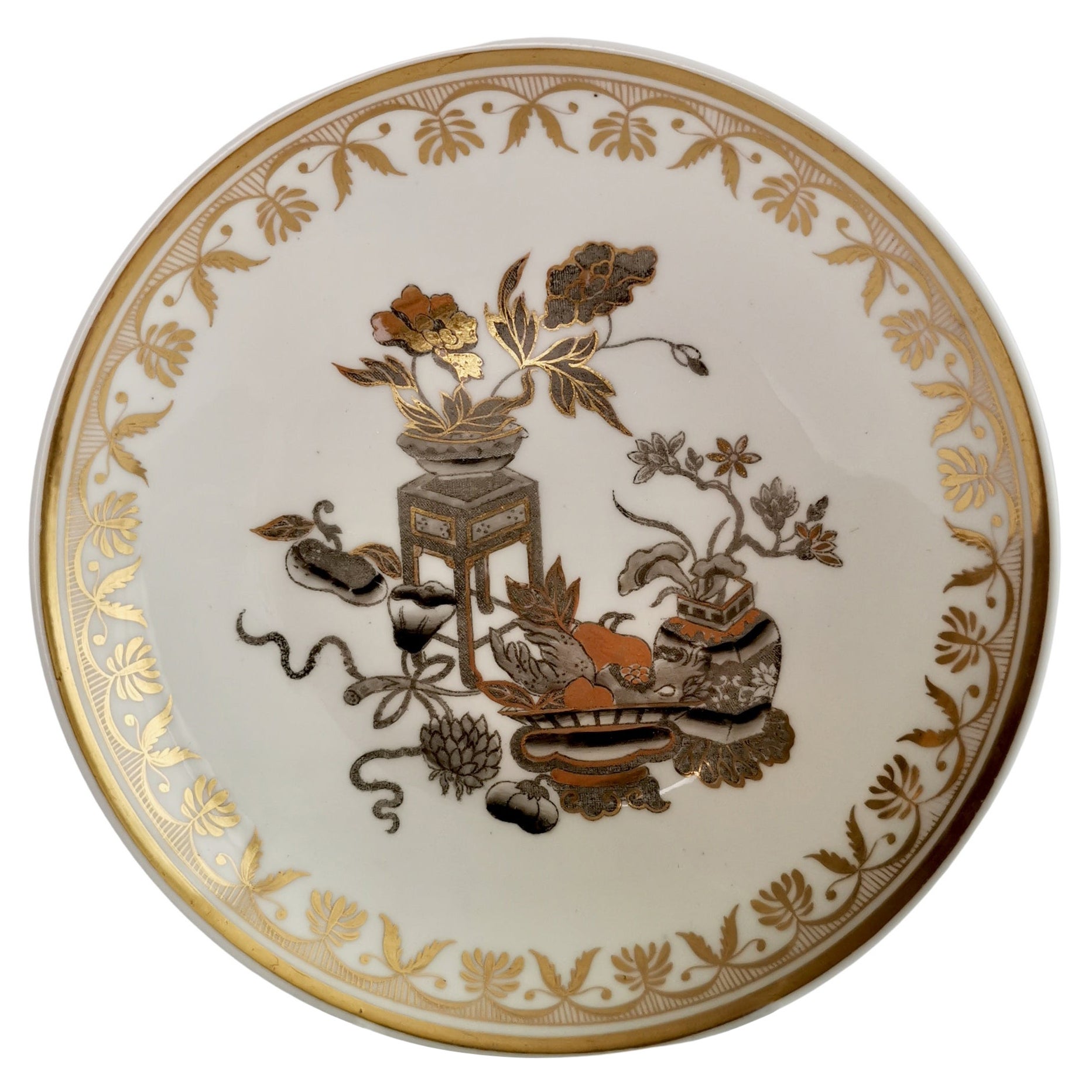Items Similar to C.J.Mason Porcelain Coffee Cup, Chinoiserie Birds Red and Gilt, ca 1830
Want more images or videos?
Request additional images or videos from the seller
1 of 16
C.J.Mason Porcelain Coffee Cup, Chinoiserie Birds Red and Gilt, ca 1830
About the Item
This is a beautiful coffee cup and saucer made by C J Mason around 1830, which was the George IV era. The items are decorated with beautiful transfer printed birds and Chinoiserie details, hand coloured in orange, terracotta and gilt.
C.J. Mason was the youngest son of Miles Mason, one of the early ones of the second wave of British porcelain makers alongside Spode and others. Miles Mason was a prominent porcelain retailer in London at the time that most porcelain came from China, imported by the East India Company. When those imports stopped in 1791 (due to the racketeering at the porcelain auctions by Mason and his fellow dealers), he seized the opportunity and started to experiment in making his own porcelain. By the early 1800s, Mason had developed both very strong ironstone, and bone china. The Masons copied the Chinese designs they used to import and became famous for large Chinoiserie dinner and dessert wares made of "Patent Ironstone", which was a new form of porcelain that was patented by C. J. Mason. However, they also made very fine porcelain tea services.
This set would have been part of such a large tea service. In those days, tea services came with coffee cups as well. This set has a nice natural Rococo Revival shape (you can see that the handle looks like a naturally grown twig) and decorated with a beautiful transfer print of the kind the Masons were famous for. Birds and Chinoiserie details are printed in terracotta, then hand coloured in fiery orange/red and picked off with a bit of gilt.
The set is unmarked as was common at the time.
Condition report The set is in excellent antique condition without any damage, repairs or crazing. There is light wear as visible in the pictures.
Antique British porcelain is never perfect. Kilns were fired on coal in the 1800s, and this meant that china from that period can have some firing specks from flying particles. British makers were also known for their experimentation, and sometimes this resulted in technically imperfect results. Due to the shrinkage in the kiln, items can have small firing lines or develop crazing over time, which should not be seen as damage but as an imperfection of the maker's recipes, probably unknown at the time of making. Items have often been used for many years and can have normal signs of wear, and gilt can have signs of slight disintegration even if never handled. I will reflect any damage, repairs, obvious stress marks, crazing or heavy wear in the item description but some minor scratches, nicks, stains and gilt disintegration can be normal for vintage items and need to be taken into account.
There is widespread confusion on the internet about the difference between chips and nicks, or hairlines and cracks. I will reflect any damage as truthfully as I can, i.e. a nick is a tiny bit of damage smaller than 1mm and a chip is something you can easily see with the eye; a glazing line is a break in the glazing only; hairline is extremely tight and/or superficial and not picked up by the finger; and a crack is obvious both to the eye and the finger. Etcetera - I try to be as accurate as I can and please feel free to ask questions or request more detailed pictures!
Dimensions (diameters) coffee cup 7.7cm (3.1"); saucer 14.8cm (5.8").
- Creator:C.J. Mason 1 (Maker)
- Dimensions:Height: 1 in (2.54 cm)Width: 1 in (2.54 cm)Depth: 1 in (2.54 cm)
- Sold As:Set of 2
- Style:George IV (Of the Period)
- Materials and Techniques:
- Place of Origin:
- Period:
- Date of Manufacture:1830
- Condition:Wear consistent with age and use. In excellent antique condition without any damage, repairs or crazing. There is light wear.
- Seller Location:London, GB
- Reference Number:
About the Seller
5.0
Platinum Seller
These expertly vetted sellers are 1stDibs' most experienced sellers and are rated highest by our customers.
Established in 2016
1stDibs seller since 2019
208 sales on 1stDibs
Typical response time: 1 hour
- ShippingRetrieving quote...Ships From: London, United Kingdom
- Return PolicyA return for this item may be initiated within 14 days of delivery.
More From This SellerView All
- Samuel Alcock Porcelain Coffee Cup, Orange Imari Flowers, Rococo Revival ca 1830By Samuel Alcock & Co.Located in London, GBThis is a beautiful coffee cup and saucer made by Samuel Alcock around 1830, which was the Rococo Revival era. The set is decorated with a bold Imari pattern and has a "ring-moulded" shape. Samuel Alcock was one of the many potters in Staffordshire such as Spode, Coalport, H&R Daniel and many others during the 1830s and 1840s. He was perhaps not the most well-known of potters but produced very high quality wares and original designs, often standing out for their bright choice of colours and beautiful shapes. The Alcock factory is not well documented so although they had a huge output, items are often mis-identified and we don't know much about the production process of artists, even though the wares have a very high quality that equals that of the more well known factories. The Rococo style was originally a style of the 18th Century. After the Baroque style, which was highly symmetrical and well-designed as it aimed to express the perfection of God, the Rococo style was a reaction that expressed the unpredictability and flow of nature. "Rococo" is derived from the French word "rocaille", which stands for a mass of pebbles that are self-organised in a completely unpredictable mess, for instance on the beach or in the mountains. Rococo moved away from the stranglehold that religion had on the arts: it was capricious, asymmetrical, charming and worldly. As Europe got mired in various wars between Germany, France and Britain, the general style got much more austere again and people embraced neo-classicism. But in the 1830s and 1840s, the seemingly unlimited fortunes of the Industrial Revolution sparked a revival of Rococo, once again creating natural shapes that are not always symmetrical and don't particularly make rational sense. This coffee cup can...Category
Antique 1830s English Rococo Revival Tea Sets
MaterialsPorcelain
- Derby Porcelain Coffee Cup, Artichoke Pattern in Turquoise, Georgian ca 1785By DerbyLocated in London, GBThis is a beautiful coffee cup and saucer made by Derby in about 1785. The set has the distinctive "artichoke" moulding and a bright turquoise ground with the white artichoke surface...Category
Antique 1780s English George III Tea Sets
MaterialsPorcelain
- Swansea Porcelain Tea Set, Tea & Breakfast Cup White and Gilt, Regency ca 1820By Swansea PorcelainLocated in London, GBOn offer is a beautiful porcelain tea set made by Swansea around the year 1820, which was the Regency era. The set consists of a white and gilt decorated teacup and a larger "breakfa...Category
Antique 1820s Welsh Regency Tea Sets
MaterialsPorcelain
- Spode Orphaned Porcelain Saucer, Chinoiserie Gilt Potted Flowers, Regency ca1820By SpodeLocated in London, GBThis is a beautiful deep orphaned saucer made by Spode around 1820. The saucer is decorated with a gorgeous Chinoiserie pattern of a group of potted flowers in gilt and grey. The sau...Category
Antique 1820s English Regency Porcelain
MaterialsPorcelain
- Bloor Derby Porcelain Breakfast Cup with Plate, Gilt with Purple Flowers, Ca1825By Derby, Bloor DerbyLocated in London, GBThis is a very charming "breakfast" teacup and saucer with a plate, made by Derby / Bloor Derby between 1806 and 1825. It is likely that the set was potted between 1806 and 1825, then decorated and brought to the market around 1825. A breakfast cup is a large teacup...Category
Antique 1820s English Regency Porcelain
MaterialsPorcelain
- Chamberlains Worcester Orphaned Coffee Cup, Sepia Flower Sprays, Georgian ca1795By Chamberlains WorcesterLocated in London, GBThis is a beautiful orphaned coffee cup made by Chamberlains Worcester in about 1795. The cup has a spirally fluted or shanked shape and is decorated...Category
Antique 1790s English George III Tea Sets
MaterialsPorcelain
You May Also Like
- Hand Painted Gilt Porcelain Tea, Coffee Cup with Desert PlateLocated in North Hollywood, CAFine gilt original porcelain coffee or tea cup with saucer and desert plate. Enjoy the start to your day with the classical sophistication of this fine p...Category
Late 20th Century French Bohemian Porcelain
MaterialsPorcelain
- Red Burgundy, Gold and Black Porcelain Coffee or Tea Cups, Set of 3, 1967Located in New York, NYA chic set of three (3) vintage red burgundy, gold, and black porcelain coffee or tea cups, Mid-20th century, 1967. Side tables shown in image search 1s...Category
Vintage 1970s Japanese Modern Porcelain
MaterialsPorcelain
- Meissen Porcelain Pink Roses Coffee Service and Embossed Decorations '11 Cups'By Meissen PorcelainLocated in Prato, TuscanyWe kindly suggest you read the whole description, because with it we try to give you detailed technical and historical information to guarantee the authenticity of our objects. Rare Meissen porcelain coffee service in Biedermeier style; the set consists of a teapot, a sugar bowl, a milk jug, and 11 cups with plate; the various pieces are made of fine hand-painted hard white porcelain with the "Pink Roses" decoration enriched on all items with sumptuous unpainted relief decorations. Unlike the simple and quite common "Pink Roses", this model is very rare, prestigious, and sought after, therefore even more expensive; in fact, the objects with this relief decoration, much more particular and detailed than others, were fired three times, while those with only the "Pink Roses" decoration only twice. Moreover, the execution of this ornamental motif with delicate and graceful flowers was entrusted only to the most experienced and skilled painters, those in possession of the prestigious diploma obtained at the "School of Drawing of Meissen" established since 1764. The knobs of the teapot and sugar bowl represent two harmonious and graceful rosebuds, also handmade; the edges of the cups and saucers are scalloped and finished with pure gold as well as the other decorations of the teapot and sugar bowl. All pieces bear the original Meissen trademark (two crossed swords) and from the enclosed list it can be stated with certainty that our service was produced between 1934 and 1944; moreover, on the objects the model is handwritten (61/106), this wording makes the artifacts even more precious and appreciated as they preserve all the characteristics of the author's calligraphy. Meissen porcelain was created in the castle of Albrechtsburg, in Meissen, a small town in Saxony near Dresden, in 1710, at the behest of Augustus the Strong (1670-1733), Prince-Elector of Saxony and King of Poland, who wanted to start production after the studies and experiments of his alchemist Bottger. Bottger discovered the formula for porcelain, in fact at that time, only the Chinese and Japanese had the recipe to create this wonderful material; Meissen was, therefore, the first porcelain produced in Europe! Bottger never revealed his formula to anyone, only a certain stage was known to the workers; we do not know, even today, in what proportions the different components are mixed; this is the great secret that allowed the famous brand to be considered the best in the world, Meissen porcelain is given the nickname of "white gold"! Through the years, Meissen has perfected its hard-paste products with high-temperature firing during its glazing. Meissen's porcelain patterns have been copied by many other manufacturers around the world such as Royal Copenhagen, Dresden, Herend, and many others, but Meissen's porcelain glaze maintains its quality over time and is superior to all (plates will not scratch with prolonged use of cutlery!). This is why even old Meissen...Category
Mid-20th Century German Biedermeier Porcelain
MaterialsPorcelain
- Porcelain Coffee Cup and Saucer "Sirenas" Designed by Dalí, N°520/1000By Salvador DalíLocated in Paris, FRWonderful Porcelain Coffee cup and saucer "Sirenas peinadas con coral and hormiga" by Salvador Dalí. The famous surrealist artist created this model in 1977 with mermaids, red vivid corals and small ants on a white background. Each piece has a gold rim on the edges giving a very luxurious aspect. Limited edition made of German porcelain produced by the Manufactory Schirnding...Category
Late 20th Century German Porcelain
MaterialsPorcelain
- Set of 10 Rosenthal Magic Flute Papageno Gilt Porcelain Bouillon Cup and SaucersLocated in Gardena, CASet of 10 Rosenthal Magic Flute Papageno Gilt Porcelain Bouillon cup and saucers 10 Rosenthal Magic Flute Papageno bouillon cup and saucer set...Category
20th Century Porcelain
MaterialsPorcelain
- Tulip Coffee Cup in Gilded Paris Porcelain by Flamen-FleuryBy Old ParisLocated in Paris, FRTulip-shaped cup with its saucer in Old Paris Porcelain. Hand-painted pieces with lovely purple and white shades, in the shape of a tulip flower. Very delicate piece with a butterfly...Category
Antique Early 19th Century French Restauration Porcelain
MaterialsPorcelain
Recently Viewed
View AllMore Ways To Browse
A C Silver
Large Porcelain Sign
Vintage Silver Cups
Antique Silver India
Mason Vintage
Antique Porcelain Tea Cup
Antique Porcelain Tea Cups
Antique Bird Light
Antique Silver Dinner Service
Antique Porcelain Service
Set Of Porcelain Birds
Orange Cups
Red And White Porcelain China
Red Glass Cups
Chinese Antique Imports
Chinese Porcelain Tea Set
Antique Rococo Porcelain
Porcelain Dessert Service





